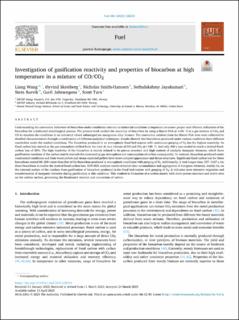| dc.contributor.author | Wang, Liang | |
| dc.contributor.author | Skreiberg, Øyvind | |
| dc.contributor.author | Smith, Nicholas Albert | |
| dc.contributor.author | Jayakumari, Sethulakshmy | |
| dc.contributor.author | Rørvik, Stein | |
| dc.contributor.author | Jahrsengene, Gøril | |
| dc.contributor.author | Turn, Scott | |
| dc.date.accessioned | 2023-04-21T11:57:08Z | |
| dc.date.available | 2023-04-21T11:57:08Z | |
| dc.date.created | 2023-03-25T19:03:30Z | |
| dc.date.issued | 2023 | |
| dc.identifier.citation | Fuel. 2023, 346, 128233. | en_US |
| dc.identifier.issn | 0016-2361 | |
| dc.identifier.uri | https://hdl.handle.net/11250/3064262 | |
| dc.description.abstract | Understanding the conversion behaviors of biocarbon under conditions relevant to industrial conditions is important to ensure proper and efficient utilization of the biocarbon for a dedicated metallurgical process. The present work studied the reactivity of biocarbon by using a Macro-TGA at 1100 °C in a gas mixture of CO2 and CO to simulate the conditions in an industrial closed submerged arc manganese alloy furnace. The conversion residues from the Macro-TGA tests were collected for detailed characterization through a combination of different analytical techniques. Results showed that biocarbons produced under various conditions have different reactivities under the studied conditions. The biocarbon produced in an atmospheric fixed bed reactor with continuous purging of N2 has the highest reactivity. Its fixed carbon loss started as the gas atmosphere shifted from the inert Ar to a mixture of CO and CO2 at 1100 °C. And only 450 s was needed to reach a desired fixed-carbon loss of 20%. The high reactivity of the biocarbon is mainly related to its porous structure and high content of catalytic inorganic elements, which favor gasification reactions of the carbon matrix towards the surrounding gas atmosphere and consumption of carbon consequently. In contrast, biocarbon produced under constrained conditions and from wood pellets and steam exploded pellets have more compact appearance and dense structures. Significant fixed carbon loss for these biocarbons started 80–200 s later than that of the biocarbon produced at atmospheric conditions with purging of N2. Additionally, it took longer time, 557–1167 s, for these biocarbons to realize the desired fixed-carbon loss. SEM-EDX analyses results revealed clear accumulation and aggregation of inorganic elements, mainly Ca, on the external surface of the residues from gasification of biocarbon produced in the fixed bed reactor with purging of N2. It indicates more intensive migration and transformation of inorganic elements during gasification at this condition. This resulted in formation of a carbon matrix with more porous structure and active sites on the carbon surface, promoting the Boudouard reaction and conversion of carbon. | en_US |
| dc.language.iso | eng | en_US |
| dc.publisher | Elsevier | en_US |
| dc.rights | Navngivelse 4.0 Internasjonal | * |
| dc.rights.uri | http://creativecommons.org/licenses/by/4.0/deed.no | * |
| dc.title | Investigation of gasification reactivity and properties of biocarbon at high temperature in a mixture of CO/CO2 | en_US |
| dc.title.alternative | Investigation of gasification reactivity and properties of biocarbon at high temperature in a mixture of CO/CO2 | en_US |
| dc.type | Peer reviewed | en_US |
| dc.type | Journal article | en_US |
| dc.description.version | publishedVersion | en_US |
| dc.rights.holder | © 2023 The Author(s) | en_US |
| dc.source.volume | 346 | en_US |
| dc.source.journal | Fuel | en_US |
| dc.identifier.doi | 10.1016/j.fuel.2023.128233 | |
| dc.identifier.cristin | 2136925 | |
| dc.relation.project | Norges forskningsråd: 294679 | en_US |
| dc.source.articlenumber | 128233 | en_US |
| cristin.ispublished | true | |
| cristin.fulltext | original | |
| cristin.qualitycode | 2 | |

